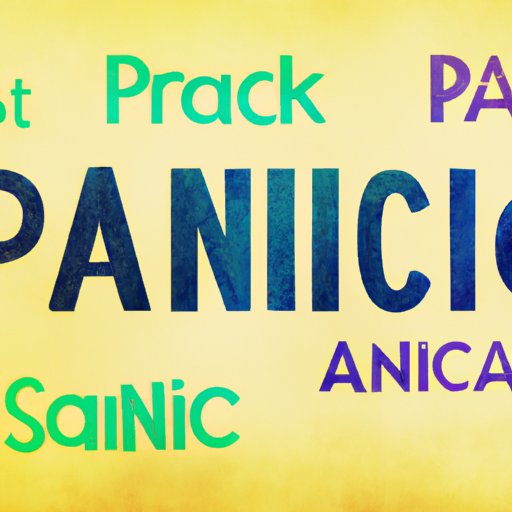Introduction
Panic attacks can be a frightening and overwhelming experience. These sudden and intense episodes of fear and anxiety can cause physical symptoms such as sweating, trembling, and heart palpitations. Panic attacks are quite common, affecting an estimated 4% of the population at some point in their lives. While panic attacks can be frightening, it is important to know that they are treatable with the right coping strategies and support.
The purpose of this article is to provide a comprehensive guide to managing panic attacks. We will explore ten proven techniques for calming panic attacks, discuss the importance of creating a panic attack survival kit, provide tips for coping with panic attacks in public, highlight the role of diet and exercise in managing symptoms, and describe the benefits of cultivating a mindfulness practice. Finally, we will emphasize the importance of seeking professional help when necessary.
10 Proven Techniques to Calm Panic Attacks
Here are ten techniques for calming panic attacks that have been proven effective:
1. Deep Breathing Exercises
Simple breathing exercises can be helpful in calming down during a panic attack.
Try the following breathing exercise:
- Sit or stand in a comfortable position, with your feet firmly planted on the ground.
- Close your eyes and take a deep breath in through your nose, counting to four.
- Hold your breath for a count of seven.
- Breathe out slowly through your mouth for a count of eight.
- Repeat this cycle of breathing for several minutes until you feel calmer.
2. Grounding Techniques
Grounding techniques can help bring your focus back to the present moment and distract you from racing and fearful thoughts.
Try this grounding exercise:
- Name five things you can see around you.
- Name four things you can touch.
- Name three things you can hear.
- Name two things you can smell.
- Name one thing you can taste.
3. Progressive Muscle Relaxation
Progressive muscle relaxation is a technique that involves tensing and then relaxing different muscle groups in your body to promote relaxation.
Follow these steps:
- Lie down or sit in a comfortable position in a quiet room.
- Close your eyes and tense a muscle group, such as your fist, for five seconds.
- Release the tension and let the muscle group relax for 10 seconds.
- Move on to the next muscle group, such as your calves or your forehead, and repeat the process.
- Continue with all of your muscle groups until you feel more relaxed.
4. Cognitive-Behavioral Therapy
Cognitive-behavioral therapy (CBT) is a type of therapy that has been shown to be effective in treating panic disorder. CBT involves identifying and challenging negative thoughts and beliefs that may contribute to panic attacks.
A CBT therapist can help you develop coping strategies for managing panic attacks and other anxiety symptoms. This type of therapy is usually conducted over a period of several weeks or months, and may involve homework assignments and other exercises to practice coping skills.
5. Other Techniques
In addition to the techniques mentioned above, there are other strategies that may be helpful in managing panic attacks.
- Distracting yourself with a calming activity, such as reading or listening to music.
- Visualizing a calming scene or situation, like a beach or forest.
- Avoiding caffeine and other stimulants that can trigger anxiety.
- Getting enough sleep and rest.
How to Create a Panic Attack Survival Kit
One effective strategy for managing panic attacks is to create a panic attack survival kit. This is a collection of items and tools that can help you feel more calm and in control during a panic attack.
What is a Panic Attack Survival Kit?
A panic attack survival kit is a personalized collection of items that can help you manage symptoms during a panic attack. You can keep your kit with you at all times, either in a small bag or container, or simply by carrying the items in your pocket or purse.
Practical Tips for Creating a Panic Attack Survival Kit
The following tips can help you create your own panic attack survival kit:
- Be mindful of what you find helpful: Think about what has helped you in the past during a panic attack, such as tactile items or calming scents.
- Personalize your kit: Include items that are specific to you and your needs, such as a favorite photo or a comforting object.
- Keep it practical: Focus on items that are easy to carry and use. For example, using a coloring book as a distraction could be an option instead of carrying paint and canvas.
- Be proactive: Pack your kit before you need it, and keep it easily accessible during periods of increased anxiety.
Items to Include in Your Panic Attack Survival Kit
Here are some items and tools you might consider including in your panic attack survival kit:
- Earplugs or headphones to block out noise
- A calming scent, such as lavender essential oil or a scented candle
- A small notebook to record your thoughts and feelings
- A distraction, such as a favorite book or crossword puzzles
- Comforting items, like a stress ball or a stuffed animal
- A list of emergency contacts for support
5 Ways to Cope with Panic Attacks in Public
Dealing with a panic attack in public can be an extremely overwhelming experience. However, there are strategies you can use to minimize discomfort and reduce the likelihood of future panic attacks.
Strategies to Manage Panic Attacks in Public
Here are five strategies that can help manage panic attacks in public:
- Focus on deep breathing: Take deep breaths and try to focus on your breath and calming thoughts instead of the fear and anxiety you are experiencing.
- Find a safe space: If possible, remove yourself from any crowded or chaotic areas to find a quieter, more peaceful environment.
- Practice visualizing a calming scene: Focus on imagining a relaxing place, such as a beach or a forest, to distract yourself from your surroundings.
- Seek support from a trusted companion: Call a friend, family member, or mental health professional for support and encouragement.
- Cognitive restructuring: Remind yourself that panic attacks are temporary, and that you are not in danger. Try using positive self-talk or mantras to affirm this.

The Role of Diet and Exercise in Managing Panic Attacks
While there is no specific diet or exercise routine that can “cure” panic attacks, healthy lifestyle habits can significantly reduce the frequency and severity of symptoms.
Effects of Diet and Exercise on Mental Health
Research has shown that eating a healthy, balanced diet and getting regular exercise can have a positive impact on mental health. Foods high in sugar or refined carbohydrates can cause spikes in blood sugar, which can contribute to anxiety and mood swings. Conversely, diets rich in omega-3 fatty acids, whole grains, and leafy greens have been shown to reduce anxiety and depression.
Exercise has also been shown to improve mental health, reducing symptoms of anxiety and depression by increasing the release of endorphins, or “feel-good” chemicals in the brain.
Suggestions for Healthy Habits That May Help Reduce Panic Attacks
Here are some healthy habits that may help reduce symptoms of panic attacks:
- Eat a balanced diet rich in whole foods, including fresh fruits and vegetables and lean protein sources.
- Avoid alcohol and caffeine, which can trigger anxiety symptoms.
- Get regular exercise by incorporating activities such as walking, yoga, or swimming into your routine.
- Practice good sleep hygiene by going to bed and waking up at the same time each day, and minimizing exposure to screens before bedtime.
The Importance of Self-Care
Self-care is key to managing any mental health condition, including panic attacks. Practicing good self-care can help reduce stress and anxiety and promote feelings of calm and relaxation.
Here are some self-care activities you can try:
- Take a warm bath or shower.
- Listen to calming music or sounds.
- Meditate or practice deep breathing exercises.
- Spend time in nature by going for a walk or hike.
- Reduce stress by practicing relaxation techniques like yoga or massage.
Cultivating a Mindfulness Practice to Manage Panic Attacks
Mindfulness is a practice of staying present and mindful in the present moment, without judging or reacting to thoughts or feelings. Cultivating mindfulness can be an effective way to manage the symptoms of panic attacks.
Introducing Mindfulness Practices
There are many mindfulness practices you can try to manage panic attacks:
- Start with a few minutes of daily meditation, focusing on your breath and body sensations.
- Try a body scan meditation, focusing on each area of your body and noticing any sensations you feel.
- Practice yoga, focusing on your breath and movements.
- Create a mindfulness ritual, like taking a walk after work.
Guidance on Incorporating Mindfulness into Daily Routine
Here are some tips for incorporating mindfulness into your daily routine:
- Start small: Begin by practicing for just a few minutes at a time, gradually increasing the length of your practice over time.
- Be consistent: Set aside a regular time each day to practice mindfulness, such as first thing in the morning or before bed.
- Maintain a non-judgmental attitude: Remember that mindfulness is about staying present in the moment, without judging yourself or your thoughts.
- Be patient: Mindfulness is a skill that takes time to develop. Be patient with yourself and don’t expect instant results.
Benefits of a Mindfulness Practice
Mindfulness practices can have many benefits, including reducing stress and anxiety, improving overall mood, and increasing feelings of calm and relaxation.
The Importance of Seeking Professional Help for Panic Attacks
While self-help strategies and lifestyle habits can be effective in managing panic attacks, it is important to seek professional help if symptoms persist or interfere with daily life.
When to Seek Professional Help
You should seek professional help if:
- Your symptoms worsen or do not improve with self-help strategies.
- You experience panic attacks frequently, or they interfere with daily life.
- You have attempted self-help and it is not working for you.
The Role of Therapy and Medication in Managing Symptoms
Therapy and medication can both be effective in managing panic attacks:
- Therapy: Cognitive-behavioral therapy (CBT) and exposure therapy have been proven effective in managing panic attacks. A therapist can help you develop coping strategies and work through the root causes of your anxiety.
- Medication: Anti-anxiety medications such as benzodiazepines may be prescribed to manage panic attacks. Antidepressants can also be effective in reducing the frequency and intensity of panic attacks.
The Importance of Finding the Right Mental Health Professional
It is important to find the right mental health professional to meet your needs. A general practitioner may be able to provide referrals or recommendations for mental health professionals who specialize in treating anxiety disorders. It is also important to find a therapist or psychiatrist who is trained in evidence-based treatments for panic disorder.
Conclusion
In conclusion, panic attacks can be a frightening and overwhelming experience, but there are many strategies you can use to manage symptoms. We have explored ten proven techniques for calming panic attacks, discussed the importance of creating a panic attack survival kit, provided tips for coping with panic attacks in public, highlighted the role of diet and exercise in managing symptoms, and described the benefits of cultivating a mindfulness practice. Finally, we have emphasized the importance of seeking professional help when necessary. Remember to be patient and kind to yourself during your journey to mental health wellness.
Take the first step towards managing your symptoms and seeking support if needed. You deserve to live a life free of fear and anxiety.
